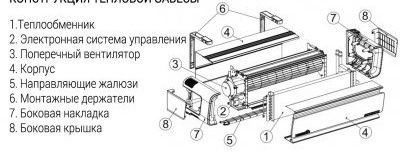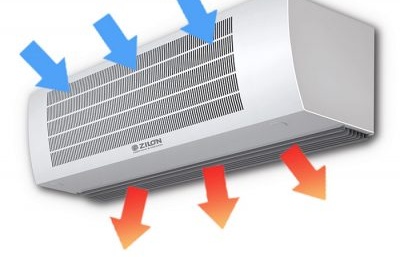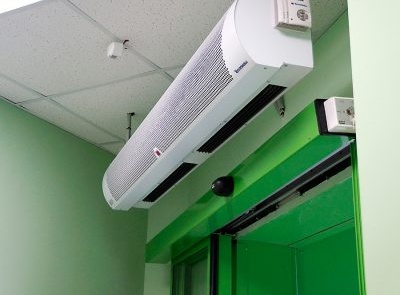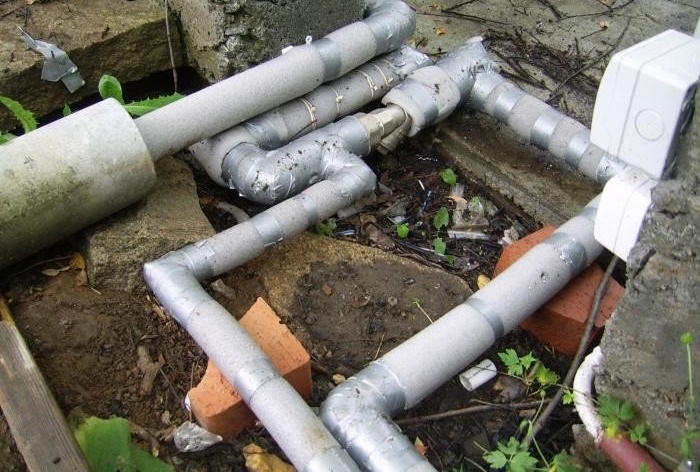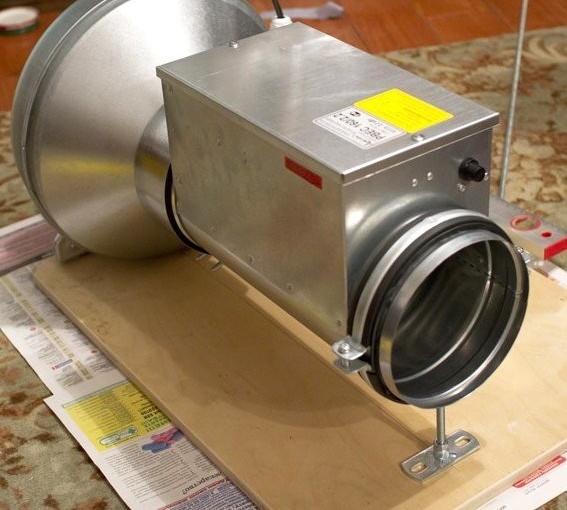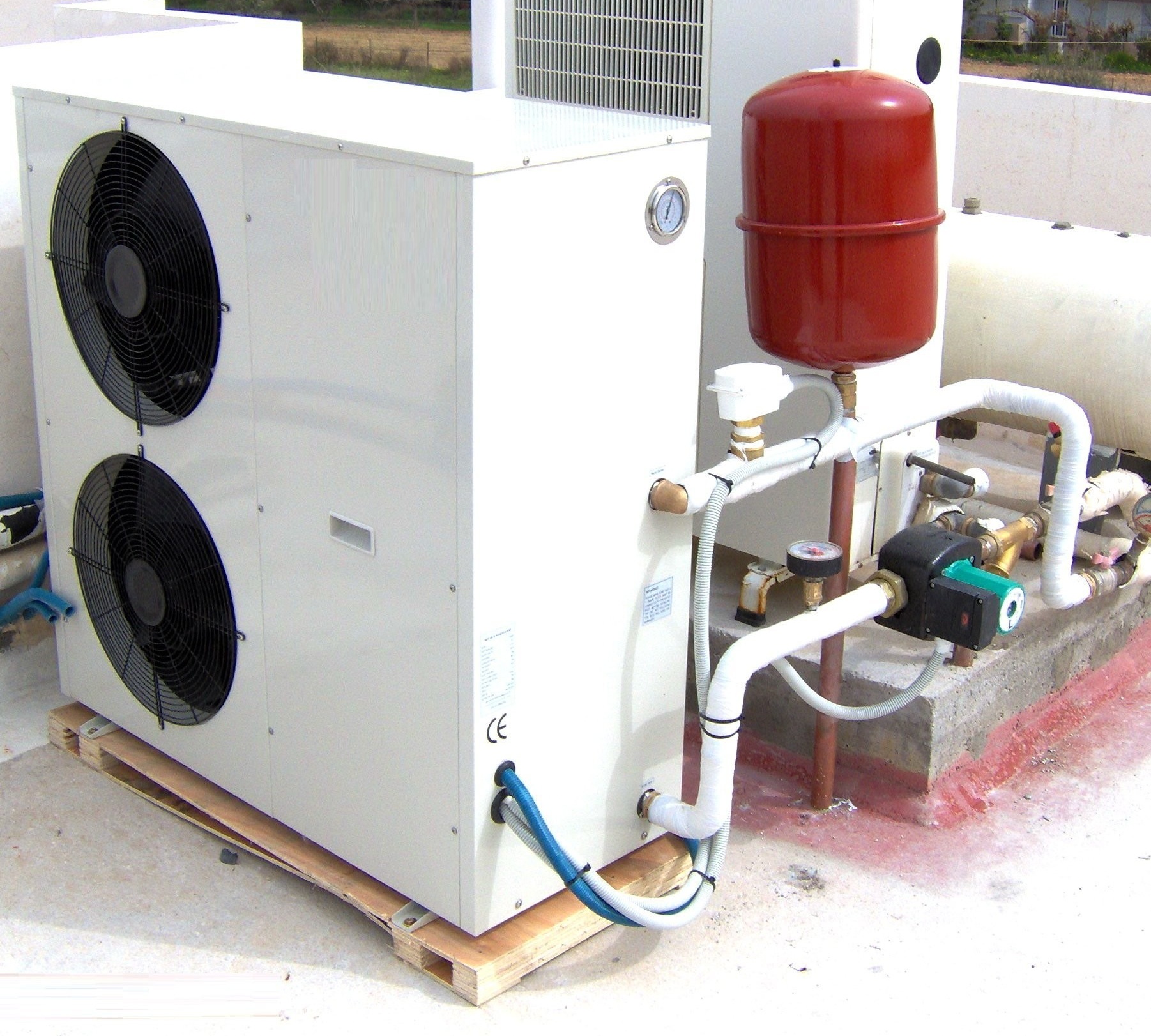Selection and installation of a thermal curtain on the front door
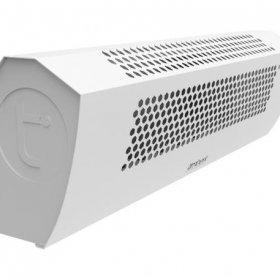
The thermal curtain on the front door is one of the innovations of our time. The purpose of this equipment is to create a protective barrier between the atmosphere inside and outside the room. The principle of cutting off cold air masses using a powerful air stream has long been used in construction and industry. But devices for protecting apartments have appeared on the market recently.
Content
What is it and what is it for
The heat curtain is one of the types of heaters that work on the principle of a fan. Externally, the device is similar to a household air conditioner:
- It has the shape of an elongated rectangle;
- on the upper and lower panels of the housing are openings for creating air flow;
- metal case.
The unit differs from heaters in that they increase the temperature of the air in the room. This is their only task. The thermal curtain has two of them:
- cut off the path to cold air directed from the street to the apartment (main function);
- to act as a heat source (secondary function).
The use of a thermal curtain of the front door allows you to save on space heating in the cold season. Experts say that with this device, the cost of paying for electricity is reduced by more than a third. Savings are due to the lack of need to connect other heat sources.
Thermal veils belong to the category of semi-industrial type heaters, so most appliances have a discreet design and concise shapes. But the leading manufacturers of this equipment understand that such devices do not always fit harmoniously into the interior of modern city apartments. And they offer consumers designer models that have a more attractive appearance. The front panel of such devices is made of shockproof glass in black or white.
Device and principle of operation
All thermal curtains are arranged and work on the same principle.
- Through the openings on the top panel, air is drawn.
- Inside the case there is a fan responsible for creating air flow in a top-down direction.
- Near the fan is a heat exchanger that heats the air passing through it.
- Some models may have a filter.
- In the lower part of the case there are openings supplying a powerful stream of air.
The devices are equipped with discharge fans of two types:
- radial (compact and light);
- tangential (have an elongated shape).
The device is controlled by buttons on the front panel or remote unit, as well as using the remote control. The device can be equipped with an air temperature control sensor. Most models are equipped with a power cable for connecting to the mains. But there are devices on the body of which only a terminal block is installed.
Advantages and disadvantages
The installation of a thermal curtain over the front door has a number of “pluses”. The main advantage is to increase the degree of comfort of living in an apartment. This is provided by several effects:
- protection against penetration of dust, odors, smog from the outside;
- elimination of drafts;
- protection against the penetration of flying insects;
- elimination of leakage from the room of the air cooled by means of the conditioner;
- maintaining a stable temperature inside the apartment.
Disadvantages of using thermal curtains were not found. Equipment of this segment heat fans It is not a necessity, but its installation significantly improves the quality of life.
How to choose a thermal curtain by type
The equipment of this segment is classified according to several criteria:
- type of installation;
- location relative to the doorway;
- type of heat exchanger and its presence.
Classification by type of installation
By type of installation, two types of models are distinguished:
- recessed;
- mounted.
Instruments of the first type are needed where attachments are inappropriate or do not fit into the design of the room. Models of built-in type will help out in those situations when the height of the lintel above the front door does not allow the installation of attachments.
Devices of the second type are the most commonly used in urban apartments and private homes. They are mounted on a wall or ceiling using brackets, take up little space and do not interfere with entry and exit.
Location classification
According to the type of arrangement, several types of thermal curtains are distinguished:
- horizontal
- vertical
- universal.
The most popular and convenient devices are the first type: horizontal. They are installed directly above the doorway and supply air flow in a top-down direction. Installation is carried out in two ways:
- using brackets;
- on fasteners.
Horizontal models can be installed on both sides of the opening, but such installation for city apartments is unreasonable. It is used to cut off cold air at the entrances to public places.
Vertical ones have more compact dimensions than horizontal ones. This is due to the peculiarity of their installation: on the right or left side of the door. It is permissible to install equipment whose height does not exceed 1/3 of the opening height.
Universal models can be installed in any position of the case: vertical or horizontal. The mobility of such curtains led to a higher demand for them than for devices of other types. Universal equipment is in demand in administrative buildings, city apartments and private houses.
Classification by type and availability of heat exchanger
According to this criterion, three types of curtains are distinguished:
- electric;
- water;
- without heat exchanger.
Electric
The most popular category of thermal curtains. This type of equipment works from 220 V mains, is lightweight and simple. Serial marking:
- RS;
- RM;
- RT.
Most models of this type are equipped with a temperature controller. This is a reasonable decision, since the energy consumption of the curtains is quite large. When warming outside, you can adjust the device so that it will give out cool air. A distinctive feature of this type of equipment is inertness. In order for the device to enter the operating mode, it needs some time, since the heat exchanger must heat up. For more powerful devices, this process is faster.
The first models of thermal curtains used spiral heat exchangers. They have many shortcomings, the main ones of which are the “burning” of oxygen and the drying of air in the room. Over time, most manufacturers abandoned this type of heat exchanger and install tubular or semiconductor in modern curtains. Such models always have the function of regulating heating.
Water
Equipment of this type (serial marking RW) is characterized by lower power consumption, since they need electricity only for the operation of the fan and the control system. In these models, hot water is the heat carrier heating the air flow. In this regard, the installation of equipment is complicated.
The heat exchanger consists of thin pipes and resembles a car radiator. The water circuit is connected to the water supply by means of pipes located on the side panels of the device. Installation of a pipeline leading to the water intake point is also necessary. Connection can be made to a heating system or domestic hot water.
The second option is preferable for the reason that when the heating is turned off, heating will be impossible. But this is not a cause for disappointment, since the heating is turned off when a positive average daily temperature is established and there is no need to heat the room.
Installation of a water thermal curtain is complicated by the fact that it requires an additional branch from the general circuit of the engineering network. It must be provided for at the stage of installation of the water supply wiring. Subsequently, it will be impossible to connect the equipment without affecting the external decoration of the premises.
An important element in the design of the device is a filter that traps sand and other impurities in the water. Since its quality often leaves much to be desired, regular cleaning of the filter will be required.
Without heat exchanger
Series marking of curtains without heat exchanger - RV. Equipment of this type performs only one function - cutting off the air masses located behind the front door. But along with this, it protects the interior from smog.
Heat guns are also used as an additional heat source. An overview of the models in our next article: https://aquatech.tomathouse.com/en/otoplenie/radiatory/teplovye-pushki.html
Criteria for choosing a thermal curtain for an apartment
When choosing a thermal curtain, the first thing you need to pay attention to is power or air flow. Equipment with a low pumping rate is not able to cut off drafts and smells, but with excessively high power - cause a feeling of discomfort and heats not only the room, but also the street.
By performance, all thermal curtains are divided into three categories:
- low pressure;
- medium pressure;
- high pressure.
RS series curtains are low-power, with a capacity of not more than 500 m³ / hour. These are inexpensive models that are installed in openings with a height of not more than 150 cm and a width of up to 80 cm. They are not suitable for installation above the front door in apartments and houses. It requires mid-range models, the RM series.
These devices are installed in openings with a height of 200–300 cm. The productivity of the equipment is 1,500–2,000 m³ / h. Most manufacturers of thermal curtains in this series equip their products with remote units, which are installed in any place convenient for owners. Equipment is controlled not only with the help of these units, but also with the remote control (remote control).
The devices of the RT series are characterized by high productivity: more than 2500 m³ / h.
If the equipment is chosen as the main source of space heating, a device with a capacity of 40 W / m³ of heated space is required. To provide additional heating, a device with a capacity of 20 W / m³ is enough.If the space in the apartment is wide, you can install several appliances in a row.
One of the most important parameters is the length of the device. It should correspond to the width of the doorway or overlap it. Otherwise, gaps through which cold air will flow are inevitable. The distribution network offers models with a length of 60-200 cm. For standard openings in apartments and private houses, equipment with a length of 80 cm is bought.
Installation of a thermal curtain on an entrance door
In most cases, for the improvement of apartments they purchase thermal curtains, powered by electricity and with a tubular or tape heat exchanger. Installing such equipment is easier than air conditioning. But despite this, manufacturers insist that the installation was carried out by specialists. However, any owner who knows how to drill walls and screw in screws will be able to install a thermal curtain with his own hands.
- Choosing an installation location. The device can be mounted directly above the opening by fixing it to a wall or ceiling.
- Markup. In accordance with the dimensions of the equipment, marks are made on the wall or ceiling. Installation is via mounting holes in the housing. All models are equipped with a mounting plate, brackets or other fasteners. In the place chosen for the installation of the curtain, the points of location of the fasteners are marked.
- Mounting brackets. With the help of a drill and a drill, holes are made in the right places. Mount the brackets with dowels and nails.
- Installation of equipment. Mount the device on the brackets.
- Mounting the control unit. On most models, the front panel must be removed to access the terminal blocks, power cable, and remote control cable. It is fixed on 8 screws. After that, the cables are fixed in the housing using clamps or seals (most often these auxiliary elements are not included in the package).
- Connect both cables to the terminal blocks, focusing on the marking.
- Install the front panel.
- Connect the curtain to the mains.
For equipment with remote control, it is necessary to install the unit, which is performed in several stages.
- Unscrewing 4 screws, remove the front cover.
- Drill holes in the wall.
- Mount the housing to the wall.
- Install the front cover.
During installation, it is important not to touch the motor, as there is a risk of misalignment of its shaft and impeller. This can lead to noise and vibration during operation of the thermal curtain.
Video: Overview of the Ballu thermal curtain
Reviews
I decided to buy a Ballu BHC-5.000 SB curtain to cut off the relaxation room in the bathhouse. Satisfied with the equipment. There is no permanent heating in the bathhouse. First, I heat the room with a veil and in half an hour you can walk naked. The floor and shoes are always dry, the humidity does not increase. Among the shortcomings can be noted noise operation. The rest are no complaints.
In our house above the front door is installed NeoClima TZT-308. I have never regretted choosing this model, as they chose to heat the hallway. Heats perfectly. But there are also disadvantages. It is impossible to smoothly adjust the temperature, you need to set it in advance, before turning it on. There is no remote control, only the unit. But it works in two power modes, there is such a regulator.
We ordered an online Ballu BHC-L08-T03 thermal curtain. We have a big house and we wanted to get not only protection from the cold and insects, but also additional heating. They were not mistaken in the choice, the veil is very powerful, it warms well. Disappointed only by one that there is no temperature controller. Installed over a door 80 cm wide. No draft through. While they were not disappointed in the veil, they are satisfied with the work.
I bought Ballu BHC-L10-S06 last year, set it over the entrance to the house. It works silently, there is a remote control. There is a temperature controller, which is very convenient with our frosty winters.When cooling, I increase the power and the house retains heat. The device itself weighs a little, not more than 8 kg. Suitable for installation on any wall.
He took the Ballu BHC-6.000 SR curtain into the garage. The device with a thermostat, overheat protection and temperature control. In winter, in cold weather at -40 ° C, he set it at a power of 6 kW. The garage was warm, the cold air did not penetrate. I decided to buy a similar one and install it in the apartment. I did not find any shortcomings in the operation of the curtain.
The thermal curtain for the front door is gaining more and more popularity every year. The above recommendations and step-by-step instructions will help you select and install equipment with optimal technical specifications.
